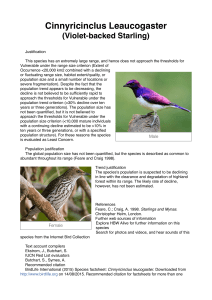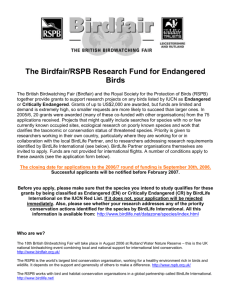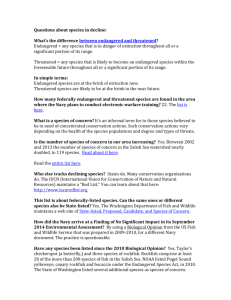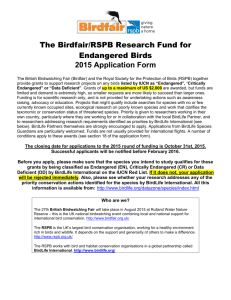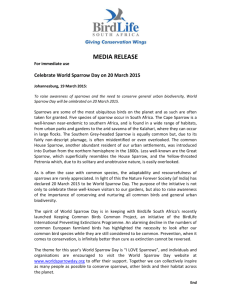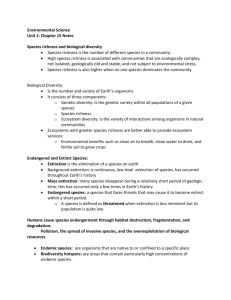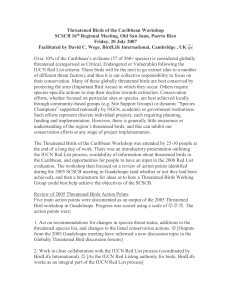BirdLife`s 2014 Red List update for birds
advertisement
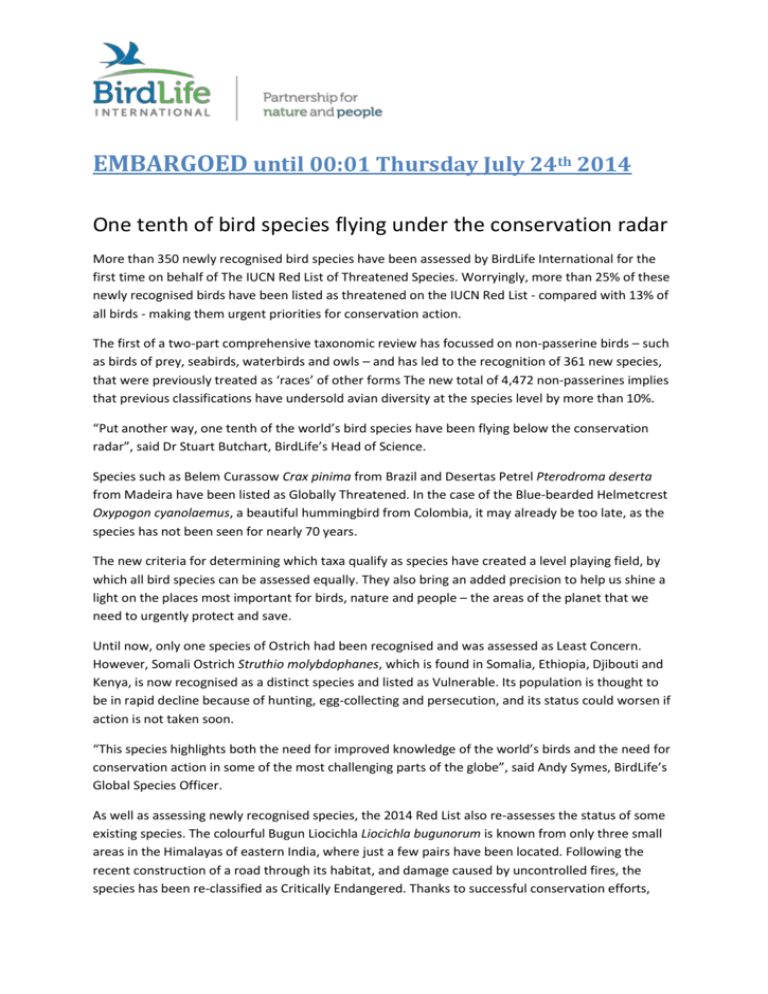
EMBARGOED until 00:01 Thursday July 24th 2014 One tenth of bird species flying under the conservation radar More than 350 newly recognised bird species have been assessed by BirdLife International for the first time on behalf of The IUCN Red List of Threatened Species. Worryingly, more than 25% of these newly recognised birds have been listed as threatened on the IUCN Red List - compared with 13% of all birds - making them urgent priorities for conservation action. The first of a two-part comprehensive taxonomic review has focussed on non-passerine birds – such as birds of prey, seabirds, waterbirds and owls – and has led to the recognition of 361 new species, that were previously treated as ‘races’ of other forms The new total of 4,472 non-passerines implies that previous classifications have undersold avian diversity at the species level by more than 10%. “Put another way, one tenth of the world’s bird species have been flying below the conservation radar”, said Dr Stuart Butchart, BirdLife’s Head of Science. Species such as Belem Curassow Crax pinima from Brazil and Desertas Petrel Pterodroma deserta from Madeira have been listed as Globally Threatened. In the case of the Blue-bearded Helmetcrest Oxypogon cyanolaemus, a beautiful hummingbird from Colombia, it may already be too late, as the species has not been seen for nearly 70 years. The new criteria for determining which taxa qualify as species have created a level playing field, by which all bird species can be assessed equally. They also bring an added precision to help us shine a light on the places most important for birds, nature and people – the areas of the planet that we need to urgently protect and save. Until now, only one species of Ostrich had been recognised and was assessed as Least Concern. However, Somali Ostrich Struthio molybdophanes, which is found in Somalia, Ethiopia, Djibouti and Kenya, is now recognised as a distinct species and listed as Vulnerable. Its population is thought to be in rapid decline because of hunting, egg-collecting and persecution, and its status could worsen if action is not taken soon. “This species highlights both the need for improved knowledge of the world’s birds and the need for conservation action in some of the most challenging parts of the globe”, said Andy Symes, BirdLife’s Global Species Officer. As well as assessing newly recognised species, the 2014 Red List also re-assesses the status of some existing species. The colourful Bugun Liocichla Liocichla bugunorum is known from only three small areas in the Himalayas of eastern India, where just a few pairs have been located. Following the recent construction of a road through its habitat, and damage caused by uncontrolled fires, the species has been re-classified as Critically Endangered. Thanks to successful conservation efforts, Bearded Vulture Gypaetus barbatus is recovering in Europe, but globally it is declining because of poisoning, disturbance and collisions with powerlines, and it has now been uplisted from Least Concern to Near Threatened. The 2014 assessment also raises the importance of several threatened bird hotspots. Many of the newly recognised species are found in South-East Asia, where biodiversity is highly threatened. Parts of this region have already been identified as globally important areas of endemism (holding many species that occur nowhere else on Earth). Some have now been shown to host even more unique species than previously thought, including the Indonesian islands of Talaud and Sangihe and parts of the Philippine archipelago, such as the island of Cebu. These areas need immediate conservation attention to protect the remaining habitat and safeguard the future of Critically Endangered birds such as Sangihe Dwarf-kingfisher Ceyx sangirensis and Cebu Brown-dove Phapitreron frontalis – neither of which have been recorded recently, but both could still be clinging on in small numbers. There are also some worrying implications for conservation on the Indonesian island of Java. Newly recognised species such as Javan Flameback Chrysocolaptes strictus (a Vulnerable woodpecker) and Javan Blue-banded Kingfisher Alcedo euryzona (Critically Endangered) show how the island has evolved many distinct species, but Java’s very high human population density means these species are now highly threatened. “The Red List is crucial not only for helping to identify those species needing targeted recovery efforts, but also for focussing the conservation agenda by identifying the key sites and habitats that need to be saved, including Important Bird and Biodiversity Areas”, said Butchart. “The updated 2014 Red List for birds will help set future conservation and funding priorities.” For more information, images or interviews please contact: Martin Fowlie: martin.fowlie@birdlife.org - tel +44 (0)1223 279813. Notes for Editors 1. Total number of species recognised by BirdLife in the 2014 Red List update is 10,425. Number of species by category as follows: Extinct 140; Extinct in the Wild 4; Critically Endangered 213; Endangered 419; Vulnerable 741; Near Threatened 959; Least Concern 7,886; Data Deficient 62. To find out more about threatened birds visit http://www.birdlife.org/datazone/sowb/spotthreatbirds 2. BirdLife International is the world’s largest nature conservation Partnership. Together we are 120 BirdLife Partners worldwide – one per country – and growing, with almost 11 million supporters, 7000 local conservation groups and 7400 staff. Find out more at www.birdlife.org / www.facebook.com/BirdLifeInternational 3. The taxonomic review involved an examination of published research and museum collections, and looked at the distinctiveness of bird populations by comparing characteristics such as plumage, measurements (biometrics) and songs. The review is based on: Tobias J.A., Seddon, N., Spottiswoode C.N., Pilgrim J.D., Fishpool, L.D.C. & Collar N.J. 2010. Quantitative criteria for species delimitation Ibis, doi: 10.1111/j.1474919X.2010.01051.x 4. The BirdLife Preventing Extinctions Programme is counteracting an increasingly diverse array of threats to birds by delivering conservation action – underpinned by science – where it is most needed. http://www.birdlife.org/worldwide/programmes/preventing-extinctions 5. BirdLife is the Red List Authority for birds for the IUCN Red List. 6. The IUCN Red List of Threatened Species™ (or the IUCN Red List) is the world’s most comprehensive information source on the global conservation status of plant and animal species. It is based on an objective system for assessing the risk of extinction of a species should no conservation action be taken. www.iucnredlist.org 7. The HBW and BirdLife International Illustrated Checklist of the Birds of the World will be published in August. For more details go to http://www.lynxeds.com/product/hbw-andbirdlife-international-illustrated-checklist-birds-world 8. Species are assigned to one of eight IUCN Red List categories of threat based on whether they meet criteria linked to population trend, population size and structure, and geographic range. Categories include: Critically Endangered (facing an extremely high risk of extinction in the wild), Endangered (facing a very high risk of extinction in the wild), Vulnerable (facing a high risk of extinction in the wild), Near Threatened (close to qualifying for Vulnerable) and Least Concern (species not qualifying for the other categories, including widespread and abundant species). Species are assigned to categories using criteria with quantitative thresholds for population size, population trend, range size and other parameters. For more information visit: http://www.iucnredlist.org. Species listed as Critically Endangered, Endangered or Vulnerable are collectively described as ‘Threatened’. 9. The IUCN Red List is a joint effort between IUCN and its Species Survival Commission, working with its Red List partners: BirdLife International; Botanic Gardens Conservation International; Conservation International; Microsoft, NatureServe; Royal Botanic Gardens, Kew; Sapienza University of Rome; Texas A&M University; Wildscreen; and Zoological Society of London. 10. IUCN, the International Union for Conservation of Nature, helps the world find pragmatic solutions to our most pressing environment and development challenges by supporting scientific research; managing field projects all over the world; and bringing governments, NGOs, the UN, international conventions and companies together to develop policy, laws and best practice. www.iucn.org 11. For all the changes, see:http://www.birdlife.org/globally-threatened-bird-forums/
